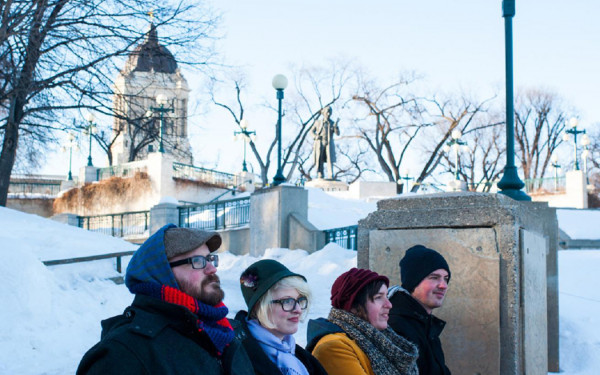RIDM Review: Stop Making Sense
To celebrate the 30th anniversary of Jonathan Demme’s exhilarating live concert film Stop Making Sense, Montreal’s RIDM film festival screened the Talking Heads’ explosive performance in Concordia’s Hall Building, as part of the festival’s ‘Beat Dox’ section. Why? “Just for pleasure,” programer Bruno Dequen explained. Shot during three performances in Los Angeles in December 1983, the film was a unique rock’n’roll event and modernist performance piece, involving a highly creative band at the height of its popularity. (The Heads had just scored their biggest mainstream success with the album “Speaking in Tongues”).
Seeing the film in this setting was a thrill and the small audience came out deliriously restless, forgetting the season’s first snows and end of term stress.
The film’s virtuosity owes as much to the Heads’ musical originality and ecstatic stage presence as to Demme’s skillful filmic orchestration and minimalistic staging, which immerse us in the band’s sonic eclecticism and electric onstage personalities. David Byrne designed the stage lighting and the elegantly plain performance-art environments (three screens used for backlit side projections; no glitter, no sleaze.
The film opens with a low-key tracking shot of David Byrne’s white sneakers walking on a bare stage. He deposits a ghetto-blaster on the floor, turns it on, straps on an acoustic guitar and fires away with classic “Psycho Killer”. Eventually, he is joined onstage by the radiant Tina Weymouth on bass (she later performs her other band Tom Tom Club’s hit ‘Genius of Love’), and visible stagehands wander out from the wings and begin to assemble a platform for drummer Chris Frantz. Gear is moved into place, electrical cables are attached, so as to clearly strip any illusion of artifice. Then arrive backup singers Edna Holt and Lynn Mabry, to amplify Byrne’s chanting with gospel exuberance, and with each song, the concert gains joyous momentum as more musicians arrive on the vast stage.
With two handheld and six lock-in cameras, director of photography Jordan Cronenweth tracks playfully across the stage in a series of long shots, to let us relish in each musician’s quirky dance moves close up, or cuts skillfully from one to the other in rhythmic unison with the songs’ dynamic verve. The dynamic cinematography really sets the concert apart by visually replicating the songs’ rhythmic pulse and frenzied repetitions. Sideway profile shots reveal a dynamic row of individually generous characters, each hopping and jiggling, up and down the stage.
The band’s flamboyant energy emerges solely through their collective performance, often cited as a mix of rock’n’roll, aerobics and pantomime. The group is a superb oddity and its members obviously enjoy nothing more than playing together.
Byrne is a stupefying performer: gaunt and slick in his oversize, light-coloured suit, handsome yet outlandishly kooky, he never, ever stops moving, whether he is jogging in place or around the entire stage, bobbing his head like a chicken or dancing with a lamp.
His geeky, birdlike appearance makes a hilarious parody of the usual frontman’s poised swagger.
Byrne surges and growls, along a driving beat, a slippery bass backbone, funky guitar currents, bubbling percussions, and whining, space-alien keyboard solos.
The sound engineering is flawless.
Very little emphasis is put throughout on the audience, but by the last number, several shots do linger on some totally loosened up and euphoric spectators, whose inhibitions have definitely been eclipsed.
The nine talking heads and their infectious vitality, greatly enhanced by the sound quality, fresh cinematography and state of the art staging, demand to be experienced full-size.
RIDM certainly supplied that privilege.
The spectator felt at arm’s distance from the band, and couldn’t refrain from jerking along, exiting happily to “Make Flippy Floppy”! Stop Making Sense, on the whole, made a lot of sense.


_600_832_s.png)



